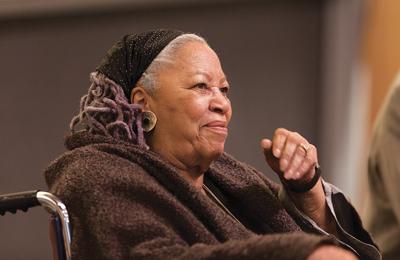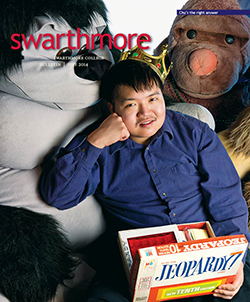Toni Morrison Day at Swarthmore
Umbrellas bobbed up and down Magill Walk in the steady spring rain, as the College community and area residents flocked to the Lang Performing Arts Center (LPAC) to hear literary great Toni Morrison in April. Soggy visitors who arrived even 30 minutes early were not able to watch from one of the 750-plus seats in Pearson-Hall Theatre, the College’s largest auditorium, as capacity had been reached. Instead, hundreds of people had to make do with gathering around one of three flat screens in the atrium.
residents flocked to the Lang Performing Arts Center (LPAC) to hear literary great Toni Morrison in April. Soggy visitors who arrived even 30 minutes early were not able to watch from one of the 750-plus seats in Pearson-Hall Theatre, the College’s largest auditorium, as capacity had been reached. Instead, hundreds of people had to make do with gathering around one of three flat screens in the atrium.
This was not the Nobel laureate’s first appearance that day. Regally seated in a wheelchair in the front of Science Center 101, Morrison, 83, met with about 50 lucky community members. The group comprised students from now-retired English literature professor Philip Weinstein’s class Faulkner, Morrison, and the Representation of Race, a few student “crashers,” and some 30 faculty and staff members who belonged to one of three Toni Morrison book clubs on campus, offered in anticipation of the Cooper Foundation–funded and sesquicentennial-related appearance. The hourlong Q&A-style gathering found a few awestruck inquisitors standing before Morrison, nervously asking questions.
Morrison, whose comportment was that of the consummate philosopher-queen, answered each inquiry with admirable on-the-fly depth. She discussed her writing process (a No. 2 pencil and a legal pad for first drafts), her drive to say more with less (hence her often thin books), and her take on worthwhile endings.
“My version of a happy ending is when somebody knows something extremely important that they didn’t know before,” Morrison said. “Happy is not enough—it’s not good enough, and it’s not important enough.”
Later, at LPAC, Morrison read an essay called “Invisible Ink,” which posits that readers are sometimes particularly primed to fill in the blanks in a text with their own projections. Then, she read aloud, for the first time, from a novel she’s writing. The audience was in absolute thrall.
As the crowd departed, a visitor grumbled that the program lasted only 38 minutes. The comment evoked a pronouncement Morrison made earlier that day, in response to a question regarding her loose narrative chronology: “Time is just an instrument. It’s just something people thought up to organize life. … Sometimes, more is just more.”
 Email This Page
Email This Page